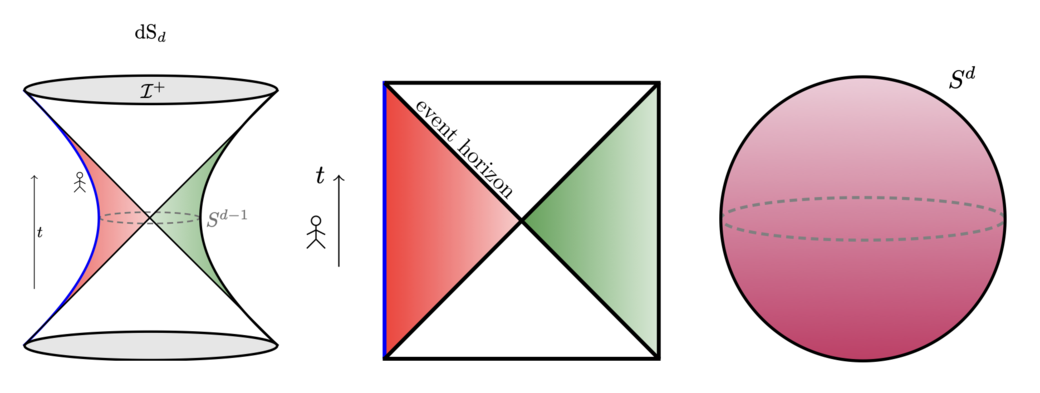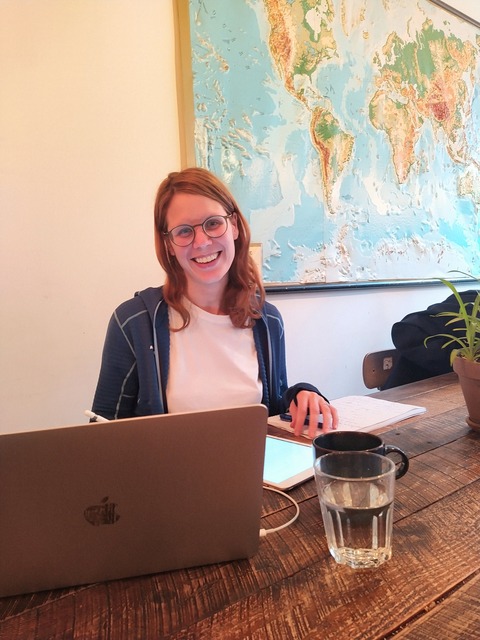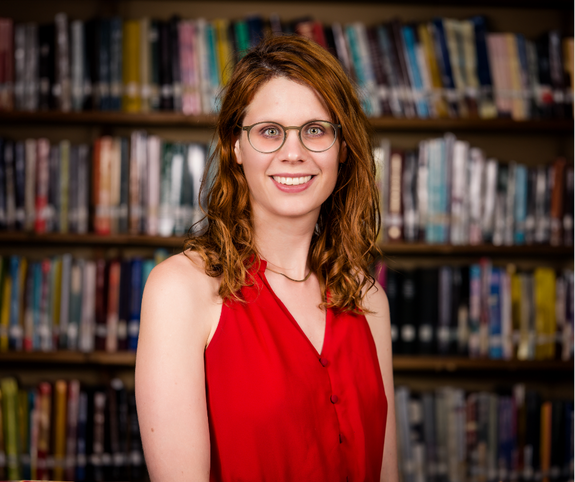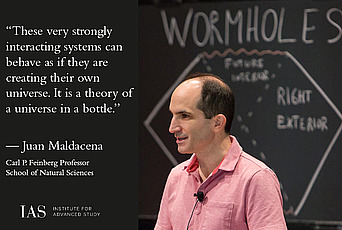Beatrix Muehlmann, Member in the School of Natural Sciences, is curious about the origin and fate of the universe. She gains insight into such questions through her study of quantum gravity, which seeks to describe gravity through the principles of quantum mechanics. Muehlmann was most recently a postdoc at McGill University and holds a Ph.D. from the University of Amsterdam.
What is your elevator pitch for describing your research?
My research focuses on developing tractable quantum gravity models in lower-dimensional spacetimes, specifically in two and three dimensions. A key aspect of my work is the integration of insights from low-dimensional quantum gravity, matrix models, and supersymmetry to construct explicit and rigorous models of de Sitter quantum gravity. Empty de Sitter space represents the future of our universe, where accelerating expansion has caused all cosmic structures to dilute.

Middle: A Penrose diagram depicting the global patch in de Sitter space (a map that shows the whole universe at once) as a square. The triangles are static patches with the diagonal lines marking the event horizon.
Right: The geometry of a Euclidean de Sitter space is a sphere. This transformation is a tool that has proven useful for understanding aspects of black hole physics. It also provides an interesting set-up for understanding features of a de Sitter spacetime.
Have any IAS scholars, past or present, influenced or impacted your research?
As a Ph.D. student, I met Dionysios Anninos who was a Member at IAS from 2014–17. He largely influenced my research interests and in particular my interest in de Sitter quantum gravity. Another former IAS Member who I collaborate with is Member (2019–23) Lorenz Eberhardt. Lorenz and I did our undergraduate studies at ETH Zürich together, so it was particularly nice to work with him many years after graduating. Another past IAS scholar who really inspires me is the mathematical physicist Emmy Noether. She frequently visited the Institute in the 1930s, during her time at Bryn Mawr College, and proved one of the most fundamental theorems in physics which says that symmetries give rise to conservation laws.
Do you have a favorite mantra or motto? If so, what is it?
I think I say "c'est la vie" a lot. It’s sort of my way to not get hung up by something. I think "supercalifragilisticexpialidocious" is also a good way to say nothing and everything at the same time.
What was your dream job as a child?
As a child, I wanted to be a judge on the Supreme Court in The Hague. I also really enjoyed my philosophy classes at school and was obsessed with reading Albert Camus for a while. When I was very little, I really wanted to be a ballerina.
Do you have any items on your bucket-list to complete while you are in Princeton?
I would like to do a pottery class and maybe learn to dance. It would also be great to learn how to do a handstand.
What do you find to be the best part of your work day?
I like morning hours. I am an early bird and it’s nice to sip a cup of coffee when heading to the office and think about what’s on my to-do list for the day.
If you could know the answer to any question, what would it be?
I think it would be awesome to understand what is and what happened at the Big Bang. This is also tied to understanding where our universe comes from.
What motivates you to overcome challenges in your work?
I think something that keeps me going is curiosity. There are so many things out there that we don’t understand yet and it’s just really wonderful to be part of a group of scientists who are trying to understand some of the most fundamental aspects and features of our universe. Of course, there are situations where progress is slow, or a project is not going anywhere, and in those situations it’s really helpful for me to talk to family and friends. It’s also important to me to do some physical exercise; I enjoy going for a run or a long walk.
What changes or evolutions occurring within your field do you find most exciting?
I think there is a renewed interest in trying to understand spacetimes that are expanding at an accelerating rate. In particular, models of de Sitter in two- and three-dimensional spacetimes are being re-explored.

What’s your favorite random fact?
Most maps of the world are wrong. On most maps, the Mercator projection (first developed in 1569) is still used. This method is quite inaccurate and makes Alaska appear as large as Brazil and Greenland, 14 times larger than it actually is. For a map to be completely accurate, it would need to be life-size and round, not flat.
There is a coffee place in Montreal where I loved to work. They have one of those 2D maps on the wall where Greenland looks just as big as Australia. So, I thought about this random fact anytime I passed by there.
What’s one unexpected thing you can’t live without as a researcher?
I find it hard to write notes on my iPad so I still mostly use a pen and notebook. I only like notebooks with squares, and I need to have some Tipp-Ex (a type of correction fluid) on hand.
What is one hometown tradition that you are bringing with you to the Institute?
I grew up in a tiny village in the German and Italian speaking part of Italy. That’s the part very close to Austria in the Dolomites. It’s not really a tradition, but growing up in the middle of the mountains has definitely influenced my appreciation for nature.



